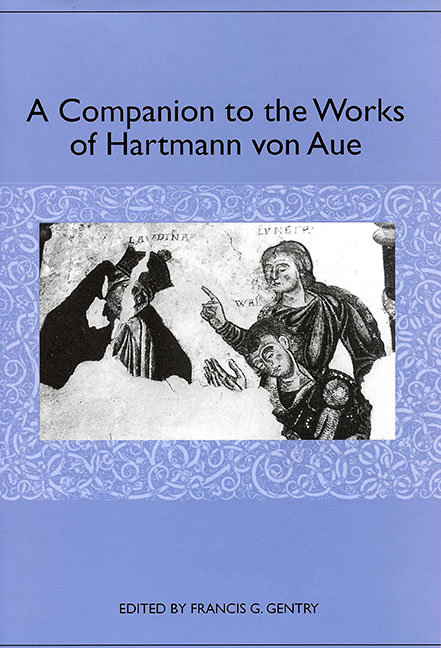Book contents
- Frontmatter
- Contents
- Acknowledgments
- Introduction
- Hartmann's Theological Milieu
- Hartmann von Aue as Lyricist
- Hartmann von Aue and Chrétien de Troyes: Respective Approaches to the Matter of Britain
- Gender and Love in the Epic Romances of Hartmann von Aue
- The Two-Fold Path: Erec and Enite on the Road to Wisdom
- The Body in Pain in the Works of Hartmann von Aue
- Illness and Cure in Hartmann von Aue's Arme Heinrich and Iwein
- Hartmann's Legends and the Bible
- Hartmann's Works in the Visual Arts
- The Medieval Literary Reception of Hartmann's Works
- A Tale of Sacrifice and Love: Literary Way Stations of the Arme Heinrich from the Brothers Grimm to Tankred Dorst
- Editions and Translations of Hartmann's Works
- Works Cited
- Notes on the Contributors
- Index
The Body in Pain in the Works of Hartmann von Aue
Published online by Cambridge University Press: 27 April 2017
- Frontmatter
- Contents
- Acknowledgments
- Introduction
- Hartmann's Theological Milieu
- Hartmann von Aue as Lyricist
- Hartmann von Aue and Chrétien de Troyes: Respective Approaches to the Matter of Britain
- Gender and Love in the Epic Romances of Hartmann von Aue
- The Two-Fold Path: Erec and Enite on the Road to Wisdom
- The Body in Pain in the Works of Hartmann von Aue
- Illness and Cure in Hartmann von Aue's Arme Heinrich and Iwein
- Hartmann's Legends and the Bible
- Hartmann's Works in the Visual Arts
- The Medieval Literary Reception of Hartmann's Works
- A Tale of Sacrifice and Love: Literary Way Stations of the Arme Heinrich from the Brothers Grimm to Tankred Dorst
- Editions and Translations of Hartmann's Works
- Works Cited
- Notes on the Contributors
- Index
Summary
In view of recent studies on the demonstrative and communicative nature of the courtly body, an investigation into the meaning of the manifestation of physical pain in Hartmann's works might offer a particularly useful and innovative approach to an analysis of his texts. Earlier research has overlooked the significance of the physical body in pain in order to concentrate either upon the inner motivation of suffering or the harmonious and refined image of courtly society dependent upon joy. Recently, others have shown that Hartmann idealizes pain and suffering in order to introduce a new model of knighthood that would have both pleased and edified his audience. While the court is undeniably the locus of cultivated joy, pain remains an enigmatic and ubiquitous force, resulting from the power relationships and struggles that surround and shape courtly culture. Within this culture, the physical body is the site upon which the effects of power, that is physical pain, are mapped and interpreted by both the individual and members of the social body. Although one might expect pain and suffering to exist in binary opposition to joy, this clear dichotomy is quite often not present. Indeed, we will see that Hartmann considers pain to be fundamental to courtly existence and that the body in pain holds a prominent position in his works.
It is important to remember, though, that the medieval understanding of pain and suffering, like that of today, is complex. Historical artifacts like courtly literature help us to discern the social significance, cultural understanding, and gendered meaning of pain and reactions to pain specific to the Middle Ages, and as we will observe in Hartmann, pain represents both a positive and negative force in the medieval point of view. Pain has a profound impact upon the construction and deconstruction of the body and self of the courtly individual (Cohen, 52–53).
Courtly culture places a great emphasis upon the observance of physical discipline and self-control, as evidenced by the importance of the Middle High German concepts of zuht (discipline), mâze (moderation), and hövescheit (courtliness). Although they ought to be innate in the noble individual, the presence of numerous didactic medieval works attest that they also had to be learned (Bumke, 67–102).
- Type
- Chapter
- Information
- A Companion to the Works of Hartmann von Aue , pp. 105 - 124Publisher: Boydell & BrewerPrint publication year: 2004



